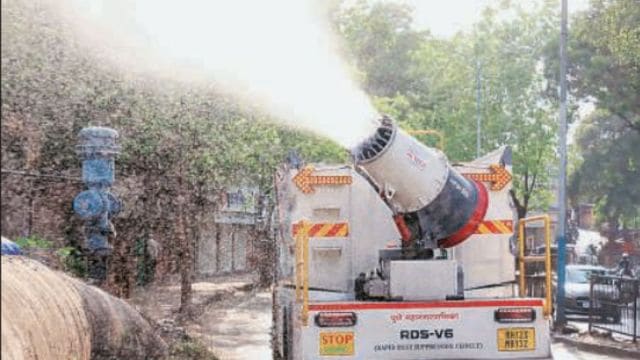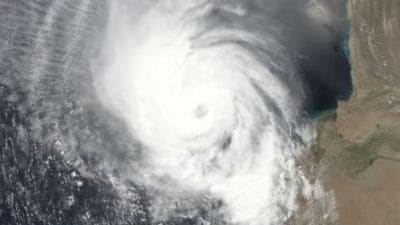Click here to join Express Pune WhatsApp channel and get a curated list of our stories
Breathless Pune | For every 10 µg/m3 increase in PM2.5 level, there was 6-8 % jump in medicine sales: Study
As respiratory problems climb with air pollution, doctors say reacting only when air quality becomes very poor in Pune would be a huge folly
 Air pollution has become a growing concern and the decline in air
quality over a decade now has posed serious risks to respiratory
health. (File Photo)
Air pollution has become a growing concern and the decline in air
quality over a decade now has posed serious risks to respiratory
health. (File Photo)Vandana Chaudhary, 43, who stays at Balewadi, has struggled with road and construction dust and is exhausted from recurring sinusitis. “I am finding it harder each day to cope with the air around me. Even with the ban on bonfires, the moment I open my window I see waste being burnt and nearby ready-mix concrete plants continue to operate in violation of norms. Poorly maintained green spaces only make things worse. I have no option but to rely on a humidifier at home and keep many plants just to avoid dust allergies, emissions and exhaust that trigger bouts of coughing. At times it is so severe that eventually I end up vomiting,” Chaudhary, who is an entrepreneur, said.
Vrinda Shendge, who has been staying at Baner–Pashan Link Road for the last two decades, said: “There were no roads then and I have literally watched this area grow. But the constant construction around here has kicked up so much dust that I don’t even feel like opening my windows anymore.” Shendge said it was essential for her to wear a mask while stepping out due to her immuno-compromised condition.
Anuja Bali, who said that she never had any allergies, is now prone to eye redness and irritation, chest congestion and migraine for the past three years. “When I discussed with doctors, I was shocked to learn that there are many more like me in Pune, called the first-time allergy patients and the numbers are increasing,” Bali said. For Bali, an educator, the topmost contributing factors for her health condition are smoke from garbage burning, construction dust and fumes from vehicle emissions. “At one time I had lost my voice, could barely speak at any forums and would cough non-stop,” she recalled.
For Reena (name changed), it is a matter of deep concern when her son, who suffers from epilepsy, experiences aggravated symptoms due to the polluted air. Watching environmental conditions trigger his seizures, leaving her feeling anxious and helpless, constantly worried about factors beyond her control. “The declining air quality not only threatens his physical well-being but also impacts us emotionally as each outing becomes a potential risk,” Reena said.
From respiratory problems, itchy skin to red, irritated eyes and even missed days of school, the impact of air pollution is pervasive, according to Bhavreen Kandhari, who co-founded ‘Warrior Moms’ a nationwide movement of mothers demanding clean air, safe environment and urgent climate action. She recalled that deteriorating air quality had led some families from Delhi and Gurugram to migrate to Pune years ago. However, they were unaware that Pune too was slowly heading in the same direction. “Their experiences make it clear that polluted air has no boundaries and what affects one city can affect another,” Kandhari, who has two daughters, said, adding that in Delhi she would not allow her daughters to play in very poor air quality conditions.
“The health risks were too high in Delhi, but in Pune too our mothers have been actively advocating for every child’s right to breathe clean air through awareness campaigns, community workshops and public installations such as their ‘white lungs’ display.
On rise in respiratory problems
Air pollution has become a growing concern and the decline in air quality over a decade now has posed serious risks to respiratory health. “It impacts people of all ages, especially children, senior citizens and those who have pre-existing lung conditions,” several doctors said. According to Dr Vijay Warad, clinical immunologist who runs the Pune Allergy Centre at Satara Road and Model Colony, there has been a rise in patients with symptoms like runny nose, headache, throat infection due to increasing pollution. “At times we even deal with emergencies where people have a sense of feeling choked and unable to breathe,” Dr Warad said.
 From respiratory problems, itchy skin to red, irritated eyes and even missed days of school, the impact of air pollution is pervasive.
From respiratory problems, itchy skin to red, irritated eyes and even missed days of school, the impact of air pollution is pervasive.
“As pollutant particles settle on pollen grains, their allergenic potency increases. These tiny combined particles can reach the smaller airways, contributing to conditions such as COPD and asthma. Larger particles tend to remain in the upper and mid-airways, leading to chronic cough syndromes. Air pollution also triggers inflammation of the nose, sinuses, eyes, and airways. It suppresses Th1-cell activity, increasing susceptibility to secondary infections involving the tonsils, adenoids, throat and respiratory tract, including pneumonia and secondary tuberculosis. As a result, more patients present with respiratory emergencies, skin conditions, and eye allergies,” he added.
Dr Ashwini Misal, Ophthalmologist at Prakash Netralaya, Pashan also noted that air pollution not only affects the lungs but irritates and damages eyes as well. “It can cause redness, irritation, stinging sensations, and allergic reactions. Children are particularly vulnerable to allergic conjunctivitis. Wearing protective eyewear when outdoors, regular use of lubricating eye drops, and maintaining good hydration are important preventive measures,” Dr Misal said.
For every 10 µg/m3 increase in PM2.5 level, there was around 6-8 % jump in medicine sales
According to a study done in Pune by Prayas Health Group, researchers examined the relationship between daily air-quality levels and the sale of respules—medications used in nebulizers for treating acute respiratory conditions. “A positive correlation between the two was seen. For every 10 µg/m3 increase in PM2.5 level, there was around 6-8 % jump in medicine sales. This jump was seen even when the PM2.5 level was below 50 µg/m³. These studies give out a clear message. To prevent the health harms associated with air pollution, the city’s air quality must remain “Good” at all times. Action must begin early and be sustained over the long term,” Ritu Parchure, Fellow with Prayas Health Group said.
“Air pollution is a multisystem threat. Air pollution doesn’t just harm the lungs, but a large number of cardiovascular ailments—including heart attacks and strokes—are also attributed to it. These illnesses are serious, often fatal and incur significant health expenditure. We get alarmed only when the AQI reaches the ‘very poor’ category. However, what is especially worrying is that the health risk begins to rise even at a much lower level of pollution. By the time air quality deteriorates to even the ‘satisfactory’ range, the risks start escalating sharply,” Parchure added.
On chest clinics and why accurate data for studying impact of air pollution on health is crucial
According to Dr Aparna Birajdar, Consultant Pulmonologist, with the rising air pollution, exposure to various inorganic and organic pollutants lead to increase and worsening of both acute and chronic respiratory conditions in Pune, especially during winter season due to increased smog formation and pollutants getting suspended in respirable range. “Although almost all private and government hospitals witness this rise in footfall in respiratory OPDs, with patients even complaining about their observations with worsening AQI, it is a mammoth task to document this scientifically, both due to lack of time and dedicated resources,” Dr Birajdar told The Indian Express.
The centre has acknowledged this issue and the Ministry of Health and Family Welfare recently in October this year issued its updated Health Advisory on air pollution under National Programme on Climate Change and Human Health. “This national programme also aims to provide services for air pollution-related cardio-pulmonary Illness through the special CHEST Clinics. The purpose of the CHEST clinic is screening and risk communication for air pollution-related cardio-pulmonary diseases, and among patients already suffering from cardio-pulmonary illnesses, to establish possible causes (including air pollution) and confirm diagnosis. The aim is to also establish CHEST clinics at sub district hospitals (subject to the availability of specialists), District hospitals, and medical colleges in urban areas, covering all such facilities in National Clean Air Programme (NCAP) cities initially. This programme, if implemented in all its sincerity, may turn out to be of great help in generating more accurate data for studying impact of air pollution on health in India as well as provide quality medical care to all patients suffering from these health impacts. We hope to see this implementation happening at its earliest in Pune,” Dr Birajdar said.
Meanwhile, Warrior Moms in Pune are engaging with policymakers and election candidates to ensure that clean air is an urgent city-wide priority. Residents like Ameet Singh, an entrepreneur committed to building carbon neutral, water positive and zero discharge society, strongly feels it is his right to know how much is the pollution in the air that we breathe and has filed a petition with the National Green Tribunal-Western Zone bench in Pune. “As a citizen it is my right to know how much is the pollution in the air we are breathing and based on data in 1/1 sq kilometre grids what effective mitigation strategies can be devised and implemented,” Singh told The Indian Express.
Click here to join Express Pune WhatsApp channel and get a curated list of our stories








